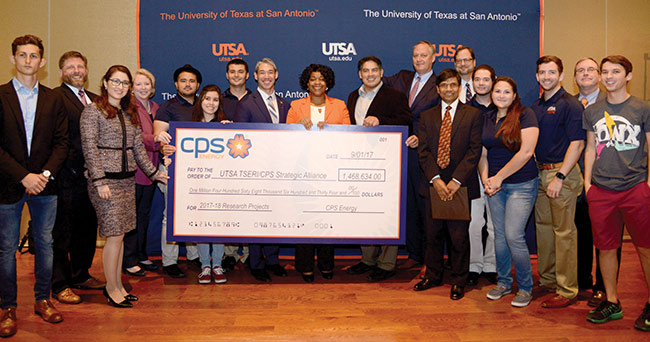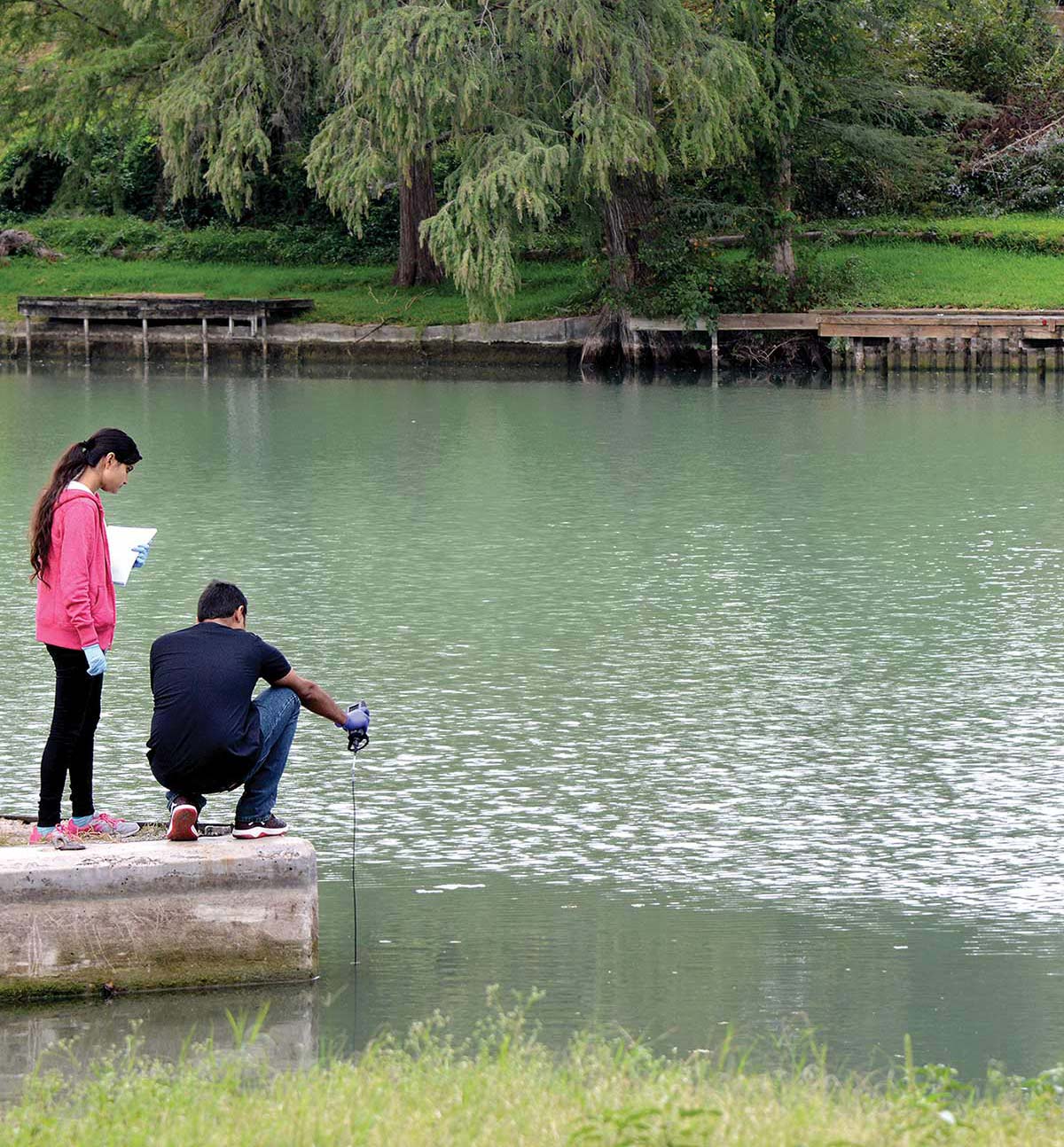
Researchers at UTSA have begun work on five new research initiatives to enhance clean energy production/integration, improve air quality, and reduce greenhouse gas emissions through the Strategic Alliance between the Texas Sustainable Energy Research Institute and CPS Energy.
Partnerships for Clean Energy
TSERI launches five innovative projects to support clean energy, climate action
Researchers at UTSA have begun work on five new research initiatives to enhance clean energy production/integration, improve air quality, and reduce greenhouse gas emissions through the Strategic Alliance between the Texas Sustainable Energy Research Institute (TSERI) and CPS Energy. The alliance was originally established in 2010. The new projects are supported by agreements with CPS Energy which total close to $1.5 million.
The Texas Sustainable Energy Research Institute was founded by UTSA in 2010 to leverage UTSA’s diverse knowledge in energy and related areas, and to position San Antonio as a significant contributor to the 21st century global energy economy. The institute integrates scientific discovery, engineering innovation, and policy deliberations with pragmatic implementation and a commitment to multicultural traditions to realize the promise of tomorrow’s America as a global energy leader.
“The work underway in our Texas Sustainable Energy Research Institute is a source of immense pride,” said JoAnn Browning, dean of the UTSA College of Engineering. “This is an exciting time for energy research. Our faculty are pursuing innovative and creative projects that I’m certain will have a lasting impact on the world around us. I am so grateful to the leadership of TSERI Director, Dr. Krystel Castillo, and Associate Dean of Research, Dr. Harry Millwater, to help solidify this partnership.”
Krystel Castillo, who is also the GreenStar Endowed Associate Professor in Energy, is facilitating the research endeavors of these five new projects representing five UTSA colleges.
The first is led by Hazem Rashed-Ali, UTSA associate professor of architecture, and includes professors Roger Enriquez, John Merrifield, Keith Muhlestein, Francine Romero, Hatim Sharif, and Rob Tillyer, who represent four UTSA colleges. Supported by a $500,000 agreement, Rashed-Ali and the team are partnering with the City of San Antonio to address climate change by developing a local plan to improve air quality and reduce greenhouse gas emissions. This new plan involves extensive research into reduction strategies that are working for other cities, community engagement approaches that will build a sense of shared goals, and input from San Antonio’s citizens. The project aims to set local goals for greenhouse gas reduction, further positioning San Antonio as a leader in clean energy initiatives.
The second project, supported by a $356,631 collaboration, is an effort to create smart buildings that can actively talk to battery energy storage systems and power grids. Researchers will develop a system to gather information about energy consumption, solar energy generation, battery status, and occupancy behavior, and have buildings operate at a high energy efficiency while maintaining indoor thermal comfort. The project has the potential to reduce customer energy bills, create more stable grid performance, and enable the deployment of additional renewable energy initiatives. Bing Dong, UTSA assistant professor of mechanical engineering, is leading this project, which includes Castillo and Jeff Xu.
In the third project, supported by a $199,690 agreement, UTSA professors are working to prevent cyber attacks from affecting smart grids using a forensics-driven approach. Raymond Choo, UTSA associate professor of information systems and cybersecurity, and Paul Rad, UTSA associate professor of information systems and cybersecurity, will lead this effort to track perpetrators of attempted cyber attacks against smart grids. The team will integrate forensics and machine learning approaches, which will allow the utility to discover the location, cause, perpetrator, time, and method of the attack. The team will also facilitate the integration of forensics tools into systems that can help the organization recover from a cyber-physical attack.
In the fourth project, researchers led by Samer Dessouky, UTSA professor of civil and environmental engineering, are harvesting alternative power from roadways. The team consists of Arturo Montoya, Athanassios Papagiannakis, Hatim Sharif, Amar Bhalla, Ruyan Guo, and Shuza Binzaid. This project received $298,881.
Dessouky’s team has created two prototypes for the project. The first uses the energetic mechanical strain induced by traffic. The second harvests energy from the heat of the asphalt. Both prototypes have a conversion module that converts energy into a stream of electric voltage that can be stored in a capacitor. The overarching aim of the project is to produce a clean and practical alternative source of power.
Finally, students led by Walter Richardson Jr., UTSA professor of mathematics, and Les Shepard, McDermott Distinguished Chair in Engineering, will apply machine learning to improve solar forecasting at the CPS Energy Joint Base San Antonio (JBSA) microgrid. Their goal is to enhance management of solar power generation and energy storage. The project, which is offically named the UTSA Sky-Imager, received $113,432 in funding. It’s a low-cost computing and camera system that provides for real-time image acquisition and processing of all-sky images. These are used to forecast intra-hour “ramp” events, which occur when low-level cumulus clouds cast shadows on the solar panels and drastically reduce power output. Accurate prediction of ramp events will allow JBSA to more efficiently manage energy generation, storage, and usage.
“The fundamental start to any advancements in technology begins with research. We understand, to be a leader, we must embrace new opportunities,” said Paula Gold-Williams, CPS Energy’s president and CEO. “We are excited to partner with TSERI and are confident that the result of their hard work will be an innovative game changer in the energy industry. We are fortunate to have a progressive resource in this field in our very own community.”
UTSA is also working with CPS Energy on opportunities for internships and employment, with the goal of preparing UTSA students for transition into jobs in the energy and sustainability fields. “We truly value the opportunity to provide internships to local students,” said Gold-Williams. “I’m humbled to know the future leaders of this company can come in at such a young age and get a head start on what is a complex industry. We welcome interns with open arms and are committed to providing them with all the support they need.”







